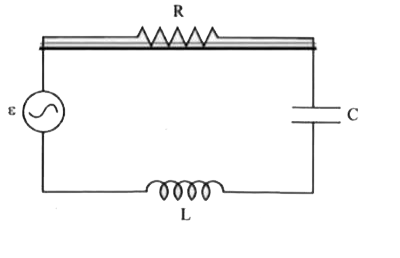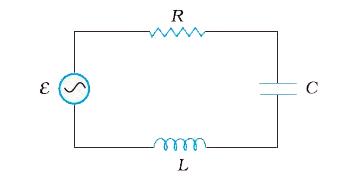A series LCR circuit is connected to a variable frequency 230 V source , L=5.0 H, C=80μF,R=40Ω
Determine the rms potential drop across L and C. Show that at resonance the potential drop across LC combination is zero.Solution in Bengali
Across L'VL=1×XL=1ωL
∴VL=8.1×50×5=2025V
Across C, VC=1ωC=8.150×80×10−6=2025V
Potential drop across LC combination =VL−VC=0
Topper's Solved these Questions
- ALTERNATING CURRENT BOOK - CHHAYA PUBLICATIONCHAPTER - ALTERNATING CURRENT EXERCISE - NCERT TEXTBOOK QUESTIONS WITH ANSWER HINT (MCQ-1)
4 Videos
- ALTERNATING CURRENT BOOK - CHHAYA PUBLICATIONCHAPTER - ALTERNATING CURRENT EXERCISE - NCERT TEXTBOOK QUESTIONS WITH ANSWER HINT (MCQ-2)
4 Videos
- ALTERNATING CURRENT BOOK - CHHAYA PUBLICATIONCHAPTER - ALTERNATING CURRENT EXERCISE - HIGH ORDER THINKING SKILL (HOTS) QUESTIONS
13 Videos
- BOOK - CHHAYA PUBLICATIONCHAPTER - EXERCISE - EXAMPLE
1 Videos
- ATOMBOOK - CHHAYA PUBLICATIONCHAPTER - ATOMEXERCISE - CBSE SCANNER
18 Videos
Similar Questions
A small town with a demand of 800 kW of power at 220 V is situated 15 km away from an electric plant generating power at 440 V. The resistance of the two wire line carrying power is 0.5Ω.km−1. The line gets power from the line through a 4000-220 V step-down transformer at a substation in the town.
Characterise the step-up transformer at the plant.
View SolutionThe current through an ac circuit first increases and then decreases as its frequency is increased. Which among the followings are most likely combination of the circuit?
View SolutionIn an oscillating LC circuit the maximum charge on the capacitor is Q. When the charge is stored equally between the electric and magnetic fields, what is the charge on the capacitor?
View SolutionThrough each of the two wires POQ and P'O'Q and electric current I is passing [Fig. 1.23]. The points Q,O,O and Q' are collinear. Determine the magnetic field at the midpoint A of OO'.

View SolutionUsing de Broglie's hypothesis , explain with the help of a suitable diagram , Bohr's second postulate of quantisation of energy levels in a hydrogen atom.
View SolutionA series LCR circuit connected to a variable frequency 230 V source has L = 5.0 H, C = 80 mu F , R = 40 Omega , Fig. (a) Determine the source frequency which drives the circuit in resonance. (b) Obtain the impedance of the circuit and amplitude of current at at resonating frequency. (c ) Determine the r.m.s. potential drops acorss the three elements the circuits. Show that the potential drop acorss the LC combination is zero at the resonating frequecny.
View SolutionFigure here, shows a series L-C-R circuit connected to a variable frequency 230 V source. L = 5.0H, C = 80 muF and r = 40 Omega (a) Determine the source frequency which drives the circuit in resonance. (b) Obtain the impedance of the circuit and the amplitude of current at the resonating frequency. (c) Determine the rms potential drops across the three elements of the circuit. show that the potential drop across the L-C combination is zero at the resonating frequency.
View SolutionFigure shows a series LCR circuit connected to a variable frequency 230 V source. L = 5.0 H, C = 80 mu F, R = 40 Omega . Determine the rms potential drops across the three elements of the circuit. Show that the potential drop across the LC combination is zero at the resonating frequency.
View SolutionA series LCR circuit is connected to a variable frequency 230 V source , L=5.0 H, C=80μF,R=40Ω
Determine the source frequency for which resonance occurs in the circuit.
View SolutionA series LCR circuit is connected to a variable frequency 230 V source , L=5.0 H, C=80μF,R=40Ω
Obtain impedance of the circuit and aplitude of current at resonance.
View SolutionFigure shows a series LCR circuit connected to a variable frequency 230 V source. L=5.0H,C=80μF,R=40Ω

a. Determine the source frequency which drives the circuit in resonance
b. Obtain the impedance of the circuit and the amplitude of current at the resonating frequency.
c. Determine the rms potential drops across the three elements of the circuit. Show that the potential drop across the LC combination is zero at the rasonating frequency .
View Solutionएक श्रेणी LCR परिपथ में L=10.0H,C=40μF तथा R=60Omega को 240V वोल्ट के परिवर्ती आवृत्ति के प्रत्यावर्ती धारा स्त्रोत से जोड़ा गया है । गणना कीजिए -(i ) स्त्रोत की कोणीय आवृत्ति जो परिपथ को अनुनाद की अवस्था में लाती है ,(ii ) अनुनादी आवृत्ति पर धारा , (iii ) प्रेरक के सिरों के बीच अनुनाद की दशा में वर्ग - माध्य - मूल विभव पतन ।
View SolutionFigure shows a series LCR circuit connected to a variable frequency 230 V source. L = 5.0 H, C = 80muF, R = 40 Omega . (a) Determine the source frequency which drives the circuit in resonance. (b) Obtain the impedance of the circuit and the amplitude of current at the resonating frequency. (c) Determine the rms potential drops across the three elements of the circuit. Show that the potential drop across the LC combination is zero at the resonating frequency.
View SolutionFigure shows a series LCR circuit connected to a variable frequency 230 V source. L=5.0H,C=80μF,R=40Ω.

(a) Determine the source frequency which drives the circuit in resonance.
(b) Obtain the impedance of the circuit and the amplitude of current at the resonating frequency.
(c) Determine the rms potential drops across the three elements of the circuit. Show that the potential drop across the LC combination is zero at the resonating frequency.
View SolutionFigure shows a series LCR circuit connected to a variable frequency 230 V source. L=5.0H,C=80μF,R=40Ω.

Determine the source frequency which drives the circuit in resonance.
View Solution
